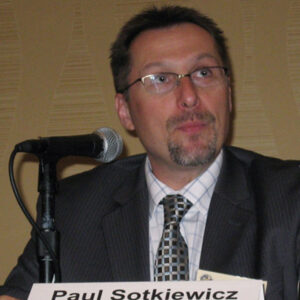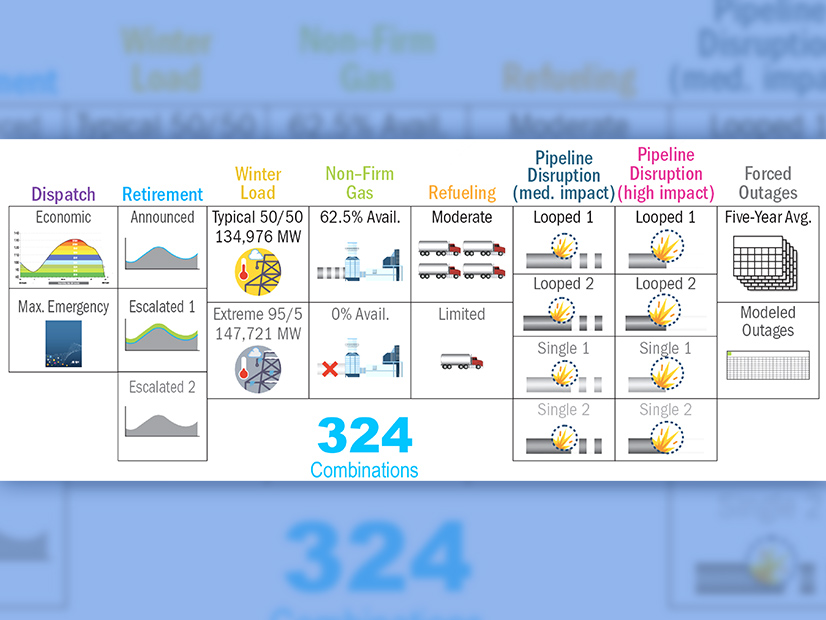Fuel Security Update
Stakeholders last week challenged PJM on the methodology the RTO used in its 2021 fuel security analysis, saying it may not be capturing all risks from severe weather and that it was “fighting the last war.”
The discussion came at the June 10 Operating Committee meeting, where Natalie Tacka, an engineer in PJM’s applied innovation department, provided an update on the fuel security initiative the RTO began in 2015. She said fuel security is part of a broader set of resilience initiatives spanning infrastructure, supply and operational criteria.
The third phase of the initiative, which is still ongoing, includes work with federal and state agencies and other industry sectors to address specific security concerns, including physical and cybersecurity risks.
Tacka said PJM continues to develop its fuel security resource adequacy assessment, using a probabilistic “stress test” of the most recent five-year ahead Regional Transmission Expansion Plan (RTEP) portfolio utilizing data from historical cold snap events. Going forward, Tacka said, the assessment will be conducted during the first quarter of each year because the RTEP portfolio is developed in February. The 2021 assessment uses the 2026/27 RTEP portfolio.
Inputs to the assessment will be updated by December of each year, Tacka said, and the updates will involve applying data on each of the inputs from the previous winter season.
Tacka said inputs in the methodology includes winter hourly load shapes derived from historical cold snaps and wind and solar capacity factors.
Jason Barker of Exelon said he was appreciative that PJM is modeling load shapes based on historical observations but asked if any modeling is being done of load shapes exceeding historical observations.
Barker said his concern is that extreme weather events exceeding historical measures are becoming more prevalent and require more testing and scenarios to determine vulnerabilities.
Patricio Rocha Garrido of PJM said the RTO is using data from the last 40 years in the assessment. He said the 40 years of data is beyond what is used in the PJM load forecast, which is about 20 years.
Garrido said winter weather conditions from 30 or 40 years ago seem to be more severe than observed today. But, he said, PJM has examined “pretty extreme” peak load values in its assessment and that it could examine weather events outside of the last 40 years to see more extreme cases.
Calpine’s David “Scarp” Scarpignato said Barker raised a point of “critical importance,” saying there could be extreme weather events on the horizon that are not being accounted for in the assessment. Scarp said there needs to be a mechanism for PJM to capture potential extreme events not even imagined.
“We need to take a look at whether we’re adequately capturing things that are not really encapsulated in the load data,” Scarp said.
Paul Sotkiewicz of E-Cubed Policy Associates said PJM should go even further in its analysis to look at correlated outages from extreme heat, not just extreme cold weather events. Sotkiewicz said the RTO should also look at unusually warm periods in the shoulder months of the spring or fall, not just summer months, to get a better representation of fuel security issues.
Sotkiewicz said PJM’s assessment effort should go beyond just looking at fuel security, moving into issues like the impacts of generation and transmission maintenance outages. He said there could be enough fuel available in an extreme weather event, but if there are too many maintenance outages at the same time, it could lead to serious consequences.

“I think we’re being too narrow minded in thinking about this as a fuel security issue,” Sotkiewicz said. “I think this is a much broader issue.”
Garrido said he agreed with broadening the scope of the assessment, but said the effort mainly revolved around forced outages resulting from fuel security because of the work done in the Fuel Security Senior Task Force. Garrido said PJM is trying to simulate as many scenarios as possible to have better data on weaknesses.
Sotkiewicz said it feels sometimes like PJM is “fighting the last war” when it comes to some issues, stressing the importance of being “proactive” so problems are taken care of the first time in an emergency.
Tom Hyzinski of GT Power Group said he agreed with Sotkiewicz’s comment about PJM “fighting the last war” and that the growing renewable generation penetration is already changing assumptions.
Hyzinski pointed out assumptions used by PJM in some of its portfolios in the presentation depict 40,000 MW of coal generation that may not be there soon. He said coal units are “dropping like flies,” pointing to the declining coal contribution in the most recent capacity auction, and that the retirement of coal units looks to be imminent. (See Capacity Prices Drop Sharply in PJM Auction.)
“Perhaps studying five years out is not good enough,” Hyzinski said. “You need to study it like the system that you could have with no coal and a lot more renewables.”
Manual 13 Changes
Rebecca Carroll of PJM reviewed proposed changes to Manual 13: Emergency Operations during a first read. Carroll said most of the changes revolve around Section 3.2: Conservative Operations, PJM’s emergency protocols to ensure the bulk electric system remains reliable during extreme events.
Carroll said the manual changes resulted from discussions at the System Operations Subcommittee (SOS) after three declarations of conservative operations were made within the last year.
The first conservative operation declaration took place in August when Tropical Storm Isaias moved through the region and PJM was experiencing unrelated “server issues” at the same time. A second conservative operation declaration was made when a severe winter storm dumped record snowfall amounts on parts of the RTO from Dec. 16-17.
The most recent conservative operations declaration came on Jan. 6 resulting from the breach of the U.S. Capitol.
Carroll said the only other time in the last 10 years PJM declared conservative operations was September 2018 when Hurricane Florence moved through the region.
PJM concluded that it was “prudent” for the RTO to conduct SOS conference calls when conservative operations are declared to share information about the event and to review and coordinate operations with stakeholders, Carroll said.
The manual language changes include authorizing PJM to conduct SOS conference calls, as needed, to review and coordinate operations with members.
Carroll said PJM received stakeholder feedback after the manual changes were first presented at the SOS this month. She said the red line changes will be presented at the June Markets and Reliability Committee meeting.
The OC will be asked to endorse the changes at its next meeting.
COVID-19 Update
Paul McGlynn of PJM provided an update on the RTO’s operations plan in response to COVID-19.
McGlynn said at the start of the pandemic last year, PJM added an Attachment F to Manual 01: Control Center and Data Exchange Requirements, which describes the requirements for remote operation of a market operation center during the pandemic.
The attachment is set to expire on June 30, McGlynn said, but PJM believes it’s “prudent” to extend the sunset date of the attachment until Dec. 31 despite the falling number of infected people.
“I’m hopeful and feel like we have the pandemic in the rearview mirror,” McGlynn said. “I think it’s been a good representation of how we pull together when we need to and do what we need to do to keep the lights on.”
Scarp said discussions regarding market suspension issues in the OC and the Market Implementation Committee show the importance of having mechanisms in place to deal with extreme events. Scarp said PJM should reconsider sunsetting Attachment F in December and asked if the RTO would be open to modifying it so it can be recalled in certain emergency situations.
Scarp said he had hoped PJM and members would come up with a better long-term solution, but maintaining Attachment F could reduce risk because stakeholders are familiar with the process after using it for more than a year.
“We should be prepared for the next thing to happen,” Scarp said.
McGlynn said PJM will consider keeping Attachment F in place and facilitate further discussions at a future OC meeting on how to make permanent changes to the attachment.
Sotkiewicz said he agreed with Scarp’s idea of keeping the attachment in place, saying serious threats like cyberattacks seem to be proliferating and require a response.
“It’s a great idea to be forward looking on this issue and to be proactive rather than reactive,” Sotkiewicz said.



